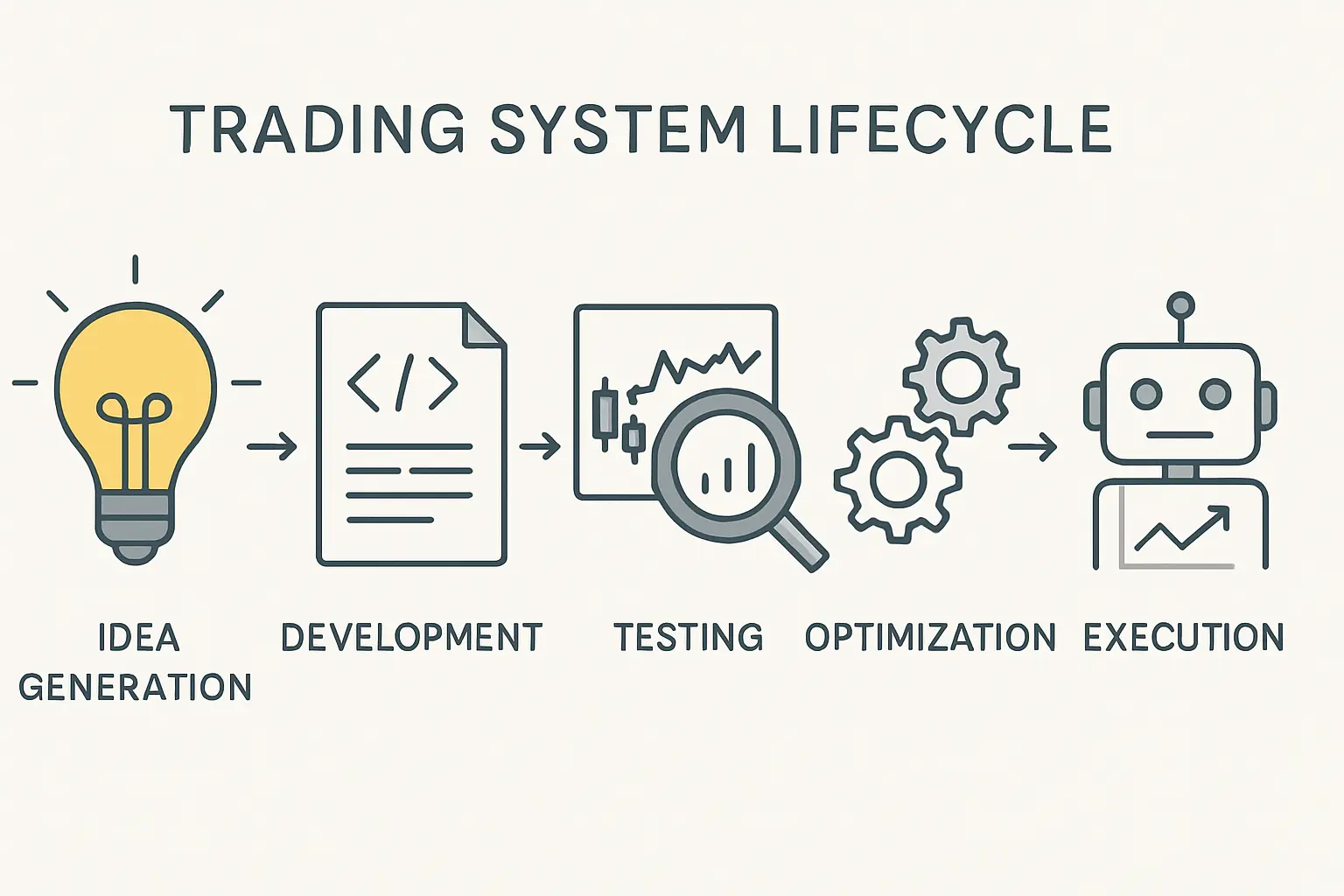Introduction

The development of a successful trading system, whether manual or automated, is not a one-time event but a continuous process. It involves a structured approach that spans from the initial spark of an idea to its ongoing maintenance and adaptation in live markets. Understanding the complete lifecycle of a trading system is crucial for traders who aim for long-term profitability and consistency. This article outlines the key stages of this lifecycle: idea generation, development, testing, deployment, monitoring, and maintenance, emphasizing the iterative nature of this journey.
Stage 1: Idea Generation
Every trading system begins with an idea. This idea can stem from various sources:
- Market Observation: Noticing recurring patterns or behaviors in price action, volume, or indicator movements.
- Economic Theory: Applying macroeconomic principles or fundamental analysis insights to predict market reactions.
- Existing Strategies: Adapting or combining elements from established trading strategies.
- Quantitative Research: Identifying statistical anomalies or correlations in market data.
- Intuition/Hypothesis: A gut feeling or a logical deduction about how the market might behave under certain conditions.
The goal at this stage is to formulate a clear, testable hypothesis about how an edge can be exploited in the market. This hypothesis should be specific enough to be translated into a set of rules.
Stage 2: Development
Once an idea is formed, the next step is to translate it into a concrete set of trading rules. This involves defining:
- Entry Conditions: Precise criteria for opening a trade (e.g., indicator crosses, price levels, time of day).
- Exit Conditions: Rules for closing a trade, including stop-loss, take-profit, and time-based exits.
- Risk Management: How much capital to risk per trade, position sizing rules, and overall portfolio risk limits.
- Market Selection: Which currency pairs, commodities, or other instruments the system will trade.
- Timeframe: The chart timeframe(s) on which the system will operate.
For automated systems, this stage involves coding the strategy into an Expert Advisor (EA) or similar program using languages like MQL4/MQL5, Python, or C#.
Stage 3: Testing
Testing is arguably the most critical stage, designed to validate the system’s edge and identify potential weaknesses before risking real capital. This stage typically involves:
- Backtesting: Running the system on historical data to simulate its past performance. This provides initial metrics like net profit, drawdown, profit factor, and win rate.
- Optimization: Fine-tuning the system’s parameters to find the most robust settings. This must be done carefully to avoid overfitting, where the system performs well on historical data but fails in live trading.
- Walk-Forward Analysis: A more advanced testing method that simulates real-world trading by periodically re-optimizing the system on recent data and testing it on unseen forward data.
- Stress Testing: Evaluating the system’s performance under extreme market conditions (e.g., high volatility, economic crises) to assess its resilience.
- Sensitivity Analysis: Examining how sensitive the system’s performance is to small changes in its parameters.
The goal is to ensure the system has a statistically significant edge and can withstand various market conditions.
Stage 4: Deployment
After rigorous testing, the system is ready for deployment. This stage involves:
- Forward Testing (Demo Account): Running the system on a demo account in real-time market conditions. This is a crucial bridge between historical backtesting and live trading, allowing for validation of execution, latency, and broker-specific nuances without financial risk.
- Live Deployment (Small Capital): Starting with a small amount of capital on a live account. This allows for real-world testing of the system’s performance with actual money on the line, while minimizing potential losses.
- Infrastructure Setup: Ensuring reliable execution environment, such as a Virtual Private Server (VPS) for automated systems, to minimize downtime and latency.
Stage 5: Monitoring
Once deployed, continuous monitoring is essential. The market is dynamic, and even a well-tested system can degrade over time. Monitoring involves:
- Performance Tracking: Regularly reviewing key metrics like equity curve, profit factor, drawdown, and win rate against expected performance.
- Slippage and Spread Analysis: Comparing actual execution prices with expected prices to identify potential issues with broker execution or market liquidity.
- System Health Checks: Ensuring the trading platform, internet connection, and any automated scripts are running correctly.
- Deviation Detection: Identifying when the system’s live performance deviates significantly from its backtested or forward-tested expectations.
Stage 6: Maintenance and Adaptation
No trading system is set-and-forget. Markets evolve, and systems must adapt. This stage is an ongoing process:
- Periodic Review: Regularly reviewing the system’s performance and underlying logic. This might involve re-evaluating the initial hypothesis.
- Re-optimization (with caution): If performance degrades, a controlled re-optimization might be necessary, again using walk-forward principles to avoid overfitting.
- Bug Fixes and Enhancements: Addressing any software bugs that arise or implementing improvements based on new market insights.
- Retirement: Knowing when to retire a system that has lost its edge or is no longer profitable. Holding onto a losing system can be detrimental to capital.
Conclusion
The lifecycle of a trading system is a continuous loop of idea generation, development, rigorous testing, careful deployment, vigilant monitoring, and ongoing maintenance. It is a journey that demands discipline, analytical skill, and a commitment to continuous learning and adaptation. By systematically navigating each stage, traders can build robust, resilient systems that have a higher probability of achieving long-term success in the ever-changing forex markets. Skipping any stage, particularly thorough testing and continuous monitoring, can lead to costly mistakes. Embrace the iterative nature of this process, and your trading systems will be better equipped to thrive.
